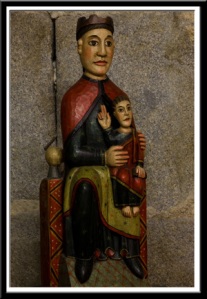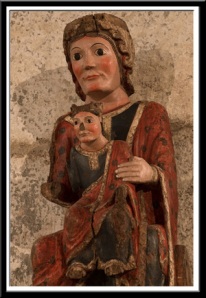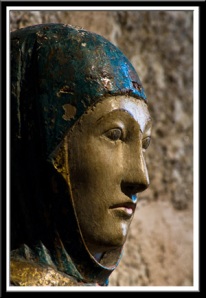Some of my favorite photographic subjects are these Throne of Wisdom madonnas, captivating and powerful iconographic images of the Romanesque era. Most of these are small (30 inch/76 centimeters), polychrome wooden statues from the 12th and 13th centuries. The Sedes Sapientiae(“Throne of Wisdom”) is an icon of the Mother of God in majesty and was found throughout Romanesque Europe.

But the woman, Mary, is not usually a young mother, but a mature woman. The child is small, but is not depicted as an infant or a baby, but rather more like a small adult. Both look directly ahead at the beholder. In few of these images will we find the maternal warmth of the Renaissance Madonna and Child (which came later) or the sorrow of the Mater Dolorosa. Instead, there is often a distant look, as if Mary is looking into the future, into the sacrifice that will be demanded of both herself and her Son. This image of one of my favorite Madonnas is from the small town of Heume l’Eglise in the Puy-de-Dôme and exhibits that wonderful melancholy.

There is a group of these Vierges that are black and have reputations for working miracles. They are, as a whole, revered as a type, as Black Madonnas. The French, who have the largest collection of them in the world, identify them as Vierges Noires. It doesn’t matter if they were not originally black, or were repainted. This very blackness of the Madonna changes the iconography of the Throne of Wisdom in some way that provokes a very powerful response. There is a great deal of speculative nonsense surrounding them, but no representation of the Mother of God was so especially venerated and they were often the specific objects of pilgrimage.

Some people profess to see the faces of these Vierges in the faces of young women in the countryside where they were carved. In the Pyreneean town of Villefranche-de-Conflent we had the extreme good fortune to meet a local priest, a hermit who carved crucifixes for the local churches. Father Joseph Raaymakers was an entertaining, generous soul who let us shoot to our hearts content in this wonderful church, and even brought out for us a lovely Vierge that was hidden from sight. Father Joseph maintains that he has gone to villages and has seen in the face of a young woman the exact visage that was represented in these ancient carvings. “Go to Montserrat,” he said, “and you will see the Madonna walking in the town.”

As a carver himself, he is completely confident that his predecessors modeled the features of their beloved Madonnas on people who they knew. Looking at the astonishing Notre Dame d’Estours from Monistrol d’Allier, one would be hard-pressed to think that this beautiful face was summoned up from someone’s imagination.

When taken as a set, these Throne of Wisdom madonnas carry enormous symbolic power, which I find compelling. In the reborn and rejeuvenated Romanesque world of France, these images symbolized the saving grace of the Church, and the protective embrace of one they considered the Mother of us all.
If you are interested in seeing more of these images, please see the Via Lucis website.

I found this post while searching for music events. Thanks for sharing will be sure to follow this blog regularly.